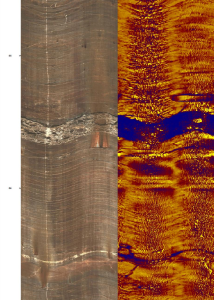Borehole imaging probes are now a common service provided in boreholes drilled for mineral exploration, geotechnical investigations and groundwater programs. The major mineral borehole imaging methods are:
- Acoustic imaging: requires a fluid filled borehole
- Optical imaging: need to be able to see the borehole wall (air or clear fluid)
Both methods are commonly requested on the same borehole due to water level being mid borehole and/or the water/fluid in the borehole is opaque and dirty. An upper optical section above the fluid level and a lower acoustic section in the borehole fluid.
Applications
Common applications are:
- Geotechnical site investigations where slope stability, rock support are key requirements.
- Tunnelling
- Structural geology.
- Casing integrity.
Borehole imaging techniques.
The imaging techniques provide an orientated image of the borehole wall (by orientation we mean a Magnetic North reference or a reference to the high side of the borehole).
Both data outputs can be used to “pick” structures for classification, orientation:
- Optical images are commonly much higher vertical resolution compared to the acoustic method, additionally the optical images are true colour and can show great detail on the rock’s character.
- Acoustic images are false colour and represent acoustic impedance contrasts of the rock. Whilst lower vertical resolution to the optical images, the acoustic data can provide high resolution caliper data to be used in subsurface stress studies and casing inspection.
The images below show the different strengths of the optical and acoustic borehole imaging methods. The optical image is to the left and the amplitude image from the acoustic scanner is to the right (both images are orientated to Magnetic North)
- Much higher vertical resolution in the optical image. See the gravel band.
- True colour of the rock in the optical image
- The sedimentary laminations can be identified in both the acoustic and optical images.
- The bright, high amplitude signature of the acoustic image indicates a hard, competent rock.

